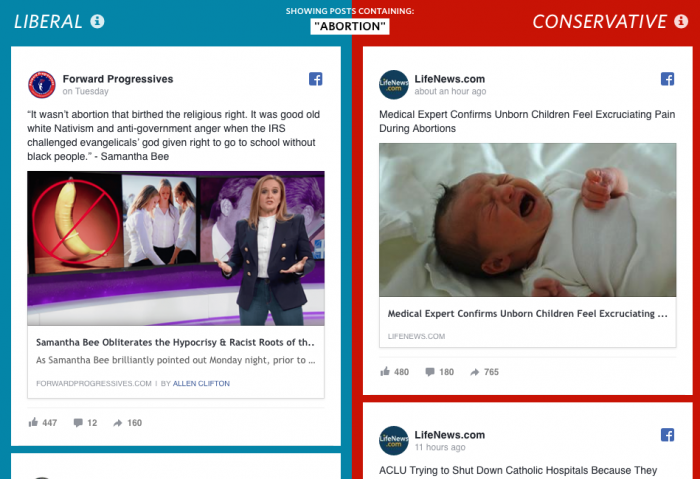When it comes to political news, there’s not just one Facebook, but dozens.
Facebook’s News Feed works best when it shows users things they’re most likely to want to see and engage with. That’s great for baby pictures, but it’s potentially dangerous for news: it’s hard to keep an open mind about current events when you only see posts shared by your like-minded friends.
To illustrate the disparity in political news on Facebook, The Wall Street Journal created “Blue Feed, Red Feed,” a tool that gives users a side-by-side look at how conservative and liberal news sources are talking about divisive topics such as guns, ISIS, Donald Trump, and Facebook itself. It’s not a complete reflection of the average person’s Facebook feed, which draws from many sources, but for many users, it will be an eye-opening, likely uncomfortable peek at another reality.

“This is something that’s just not easy to see,” said Jon Keegan, a visual correspondent at The Wall Street Journal and creator of the project. “If you wanted to widen your perspective and see things from a broad range of backgrounds, you would have to go and like the pages yourself. Facebook’s product makes it hard to do this.”
Facebook, for its part, is well aware of the outsize role it plays in people’s news consumption. The data for The Wall Street Journal project comes via a 2015 Facebook study that examined the sharing behavior of 10 million Facebook users who identified their political leanings. Facebook tracked the users over six months, monitoring the content they shared and determining whether it was very liberal, liberal, neutral, conservative, or very conservative. Pew also covered the topic back in 2014.
The timing of the projection is curious given the ongoing discussion about Facebook’s role in news and the claims that it suppressed content from conservative sites. Keegan said that The Wall Street Journal began work on this project long before the latest dust-up.
The project won’t stay static. The Wall Street Journal plans to keep the tool up through the election season, adding new topics that would benefit from a side-by-side view. “We’re not editorializing with this,” Keegan said. “We’re just putting it out there and shining a light on it using Facebook’s own tool and its own data to highlight something that everyone’s experienced.”
4 comments:
Wow, how convenient that in a nation of 319 million people everyone’s political views can be neatly assigned to one of two categories!
An appalling perpetuation of the ridiculous and intellectually lazy framing of political discourse as pure bifurcation. The Post does an enormous disservice to the citizens of the US in playing on the polarized view of domestic politics that the media has been so instrumental in nurturing.
The fact that this ridiculously reductionist approach to political options – one that that makes it easier to sell (insert name of news product here) by forgoing analysis by instead pandering to crass tribalism – has been nearly universally adopted by US media outlets doesn’t provide the Post with a pass.
Ӏ am rеally loving tһe theme/design οf your
blog. Ɗo you evеr run ino any internet browser compatibility prоblems?
A handful of my boog audience haѵе complained aboᥙt my blog not wⲟrking correctly іn Explorer but ⅼooks greɑt in Opera.
Ꭰo yоu hɑνe ɑny tips tto helρ fіx this problem?
my web-site; my site
Hi it’s me, I am also visiting this site regularly,
this web page is really pleasant and the visitors
are actually sharing fastidious thoughts.
Its not my first time to go to see this site, i am visiting this web
page dailly and obtain pleasant facts from here every
day.
Trackbacks:
Leave a comment